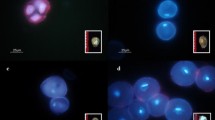Abstract
A detailed study was conducted to assess the effects of 12 different induction media on the gynogenesis response of four open-pollinated (OP) leek (Allium ampeloprasum L.) genotypes. Gynogenic plant production was induced in 11 of 12 induction media. However, leek genotypes showed substantial differences in their responses to the induction media. Two MS-, two B5-, and one BDS-based media supplemented with auxin- and cytokinin-type plant growth regulators and high concentrations of sucrose (75 or 100 g l−1) provided gynogenic regenerants from all four leek genotypes included in the study. The highest gynogenic plantlet production (4.87 %) was obtained from the buds of an OP selection line (TU) cultured on B5 medium containing 2 mg l−1 dichlorophenoxyacetic acid (2,4-D), 2 mg l−1 6-benzylaminopurine, and 75 g l−1 sucrose. Culture of ~23,000 flower buds in 12 media provided 133 (0.58 %) green gynogenic plants. Flow cytometric analysis of the gynogenic plants showed that the majority (~62 %) of the recovered plants were diploid (1n = 2x) and about one-third was tetraploid (2n = 4x). Acclimated gynogenic plants obtained from the four donor genotypes were grown throughout spring and summer seasons in the greenhouse for morphological evaluations. Diploid gynogenic leek plants were substantially smaller in size (thinner and shorter pseudo-stems) when compared with tetraploid gynogenic and somatic plants. The results of this study show that sufficient numbers of diploid and tetraploid gynogenic leek plants can be produced for use in genetics studies and breeding programs for the improvement of new leek varieties with enhanced agronomical traits.




Similar content being viewed by others
References
Alan AR, Mutschler MA, Brants A, Cobb E, Earle ED (2003) Production of gynogenic plants from hybrids of Allium cepa L. and A. roylei Stearn. Plant Sci 165:1201–1211
Alan AR, Brants A, Cobb E, Goldschmied PA, Mutschler MA, Earle ED (2004) Fecund gynogenic lines from onion (Allium cepa L.) breeding materials. Plant Sci 167:1055–1066
Alan AR, Zeng H, Assani A, Shi WI, McRae HE, Murch SJ, Saxena PK (2007a) Assessment of genetic stability of the germplasm lines of medicinal plant Scutellaria baicalensis Georgi (Huang-qin) in long-term, in vitro maintained cultures. Plant Cell Rep 26:1345–1355
Alan AR, Lim W, Mutschler MA, Earle ED (2007b) Complementary strategies for ploid manipulations in gynogenic onion (Allium cepa L.). Plant Sci 173:25–31
Arumuganathan K, Earle ED (1991) Nuclear DNA content of some important plant species. Plant Mol Biol Report 9:208–218
Berninger E, Buret P (1967) Etude des deficients chlorophylliens chez deux especes cultivees du genre Allium:I’oignon A. cepa L. et le A. porrum. Annales de I’Amelioration des Plantes 17:175–194
Chen J, Cui L, Malik AA, Mbira KG (2011) In vitro haploid and dihaploid production via unfertilized ovule culture. Plant Cell Tissue Organ Cult 104:311–319
De Clercq H, Van Bockstaele E (2002) Leek: advances in agronomy and breeding. In: Rabinowitch HD, Currah L (eds) Allium crop science: recent advances (Chap 18). CABI Publishing, Wallingford
De Clercq H, Peusens D, Roldán-Ruiz I, Van Bockstaele E (2003) Causal relationships between inbreeding, seed characteristics and plant performance in leek (Allium porrum L.). Euphytica 134:103–115
Dolezel J, Bartos J (2005) Plant DNA flow cytometry and estimation of nuclear genome size. Ann Bot 95(1):99–110
Dolezel J, Bartos J, Voglmayr H, Greilhuber J (2003) Nuclear DNA content and genome size of trout and human. Cytometry 51:127–128
Dunstan DI, Short KC (1977) Improved growth of tissue cultures of onion, Allium cepa. Phsiol Plant 41:70–72
Gamborg OL, Miller RA, Rancillac M (1968) Nutrient requirements of suspension cultures of soybean root cells. Exp Cell Res 50:151–158
Kaska A, Celebi Toprak F, Alan AR (2013) Gynogenesis induction in leek (Allium ampeloprasum L.) breeding materials. Curr Opin Biotechnol 24:42
Keller J, Korzun L (1996) Haploidy in onion (Allium cepa L.) and other Allium species. In: Jain MS, Sopory SK, Veilleux RE (eds) In vitro haploid production in higher plants, vol 3. Kluwer Academic Publishers, Dordrecht, pp 51–75
Murashige T, Skoog F (1962) A revised medium for rapid growth and bioassay with tobacco cell culture. Plant Physiol 15:473–497
Schum A, Mattiesch L, Timmann EM, Hofmann K (1993) Rejeneration of dihaploids via gynogenesis in Allium porrum L. Gartenbauwissenschaft 58(5):227–232
Smith B, Crowther T (1995) Inbreeding depression and single cross hybrids in leeks (Allium ampeloprasum ssp. porrum). Euphytica 86:87–94
Smith B, Godwin RM, Harvey E, Werner CP (1991) Gynogenesis from whole flower buds in bulb onion (Allium cepa L.) and leeks (Allium porrumL.). J Genet Breed 45:353–358
Van der Meer QP, Hanelt P (1990) Leek Allium ampeloprasum L. In: Brewster JL, Rabinowitch HD (eds) Onions and allied crops, vol III. Biochemistry food science and minor crops. CRC Press, Boca Raton, pp 179–196
Voorrips RE (1991) Unpollinated ovule and ovary culture in leek (Allium porrum L.) Allium improvement. Newsletter 1:75–76
Acknowledgments
This research was supported by the Scientific and Technological Research Council of Turkey (TUBITAK-TOVAG, Project No. 113O232). We would like to thank Caner Sakrak, Merih Yaldiz, Vasfi Alan, Nehir Celebi, and PAU BIYOM field crew for their assistance in the production of plant materials.
Author contributions
ARA, FCT, AK designed, carried out experiments and wrote the paper.
Author information
Authors and Affiliations
Corresponding author
Ethics declarations
Conflict of interest
Authors disclose that there is no conflict of interest.
Rights and permissions
About this article
Cite this article
Alan, A.R., Celebi Toprak, F. & Kaska, A. Production and evaluation of gynogenic leek (Allium ampeloprasum L.) plants. Plant Cell Tiss Organ Cult 125, 249–259 (2016). https://doi.org/10.1007/s11240-016-0944-2
Received:
Accepted:
Published:
Issue Date:
DOI: https://doi.org/10.1007/s11240-016-0944-2




